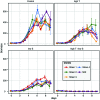Genetic diversity and ecosystem functioning in the face of multiple stressors
- PMID: 23028735
- PMCID: PMC3445582
- DOI: 10.1371/journal.pone.0045007
Genetic diversity and ecosystem functioning in the face of multiple stressors
Abstract
Species diversity is important for a range of ecosystem processes and properties, including the resistance to single and multiple stressors. It has been suggested that genetic diversity may play a similar role, but empirical evidence is still relatively scarce. Here, we report the results of a microcosm experiment where four strains of the marine diatom Skeletonema marinoi were grown in monoculture and in mixture under a factorial combination of temperature and salinity stress. The strains differed in their susceptibility to the two stressors and no strain was able to survive both stressors simultaneously. Strong competition between the genotypes resulted in the dominance of one strain under both control and salinity stress conditions. The overall productivity of the mixture, however, was not related to the dominance of this strain, but was instead dependent on the treatment; under control conditions we observed a positive effect of genetic richness, whereas a negative effect was observed in the stress treatments. This suggests that interactions among the strains can be both positive and negative, depending on the abiotic environment. Our results provide additional evidence that the biodiversity-ecosystem functioning relationship is also relevant at the level of genetic diversity.
Conflict of interest statement
Figures





References
-
- Naeem S, Bunker DE, Hector A, Loreau M, Perrings C (2009) Biodiversity, ecosystem functioning, and human wellbeing: an ecological and economic perspective. Oxford: Oxford University Press.
-
- Cardinale BJ, Matulich K, Hooper DU, Byrnes JE, Duffy E, et al. (2011) The functional role of producer diversity in ecosystems. American Journal of Botany 98: 572–592 doi: 10.3732/ajb.1000364. - DOI - PubMed
-
- Hooper DU, Adair EC, Cardinale BJ, Byrnes JEK, Hungate BA, et al.. (2012) A global synthesis reveals biodiversity loss as a major driver of ecosystem change. Nature. doi: 10.1038/nature11118. - DOI - PubMed
-
- Griffin JN, O'Gorman EJ, Emmerson MC, Jenkins SR, Klein A-M, et al.. (2009) Biodiversity and the stability of ecosystem functioning. In: Naeem S, Bunker DE, Hector A, Loreau M, Perrings C, editors. Biodiversity, ecosystem functioning, and human wellbeing: an ecological and economic perspective. Oxford: Oxford University Press. 78–93.
-
- Frankham R (2005) Genetics and extinction. Biological Conservation 126: 131–140 doi: 10.1016/J.Biocon.2005.05.002. - DOI
Publication types
MeSH terms
LinkOut - more resources
Full Text Sources

